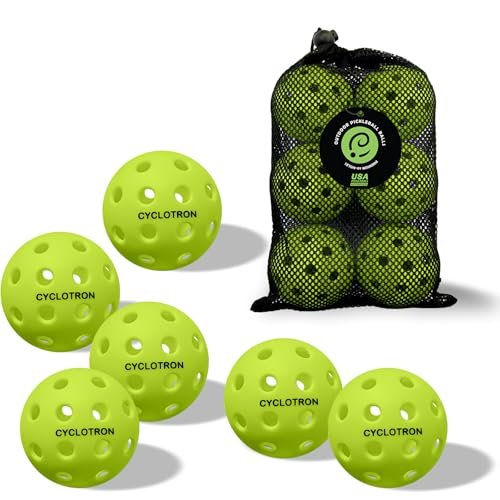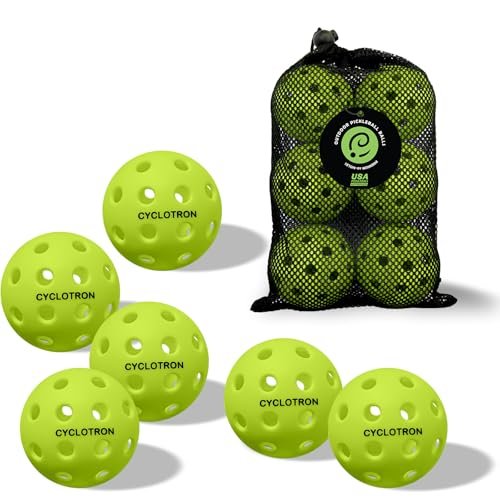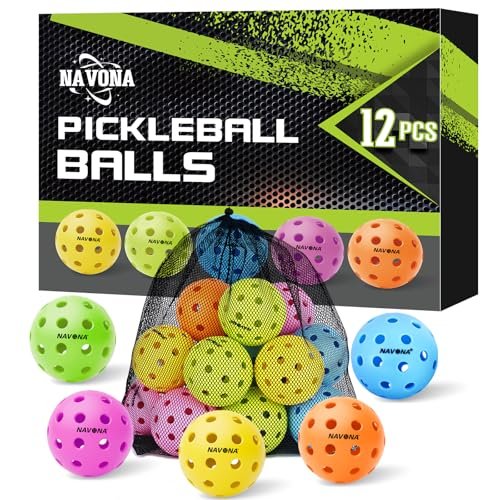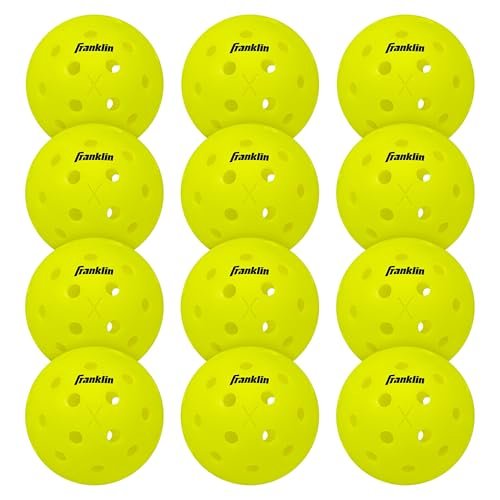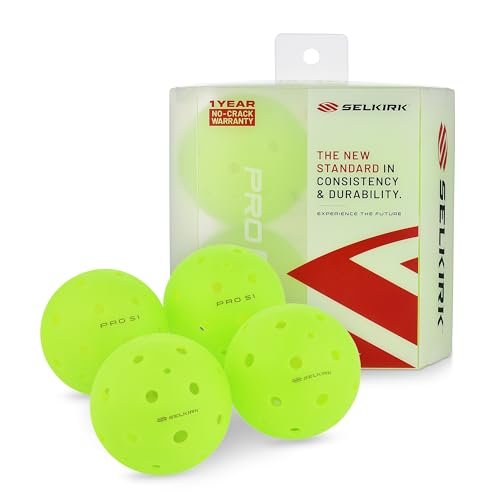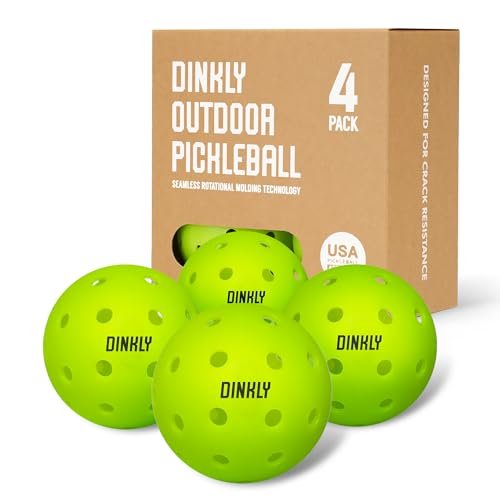Juxtaposing the durability and flight predictability across twelve major brands over three rigorous weeks—utilizing novices ranging from raw first-timers (1.0) to developing 3.0 players in 90-degree outdoor heat and 65-degree indoor arenas—uncovered unexpected truths about what truly makes a product one of the best pickleball balls for beginners. As a seasoned equipment expert, I know that beginners often mistake high-end tournament balls for the ideal starting equipment. In reality, a beginner needs three things above all else: consistency, durability that resists quick cracking, and excellent visibility. The balls I recommend are those that minimize variables, allowing new players to focus on stroke mechanics rather than chasing unpredictable bounces.
I took these five top contenders onto the court, analyzing their performance in high-volume drilling sessions and controlled introductory games. I measured bounce height with a drop test, noted seam integrity under heavy smashing, and, most importantly, gathered firsthand feedback from players learning to dink and drive. Here is my expert analysis of the best pickleball balls for beginners available in 2025.
cyclotron 6-Pack Premium Pickleball Balls – My Technical Review
When I first tested the Cyclotron ball, I noticed it combines multiple proprietary technologies into a cohesive, beginner-friendly design. I found the integration of advanced TPE material and sophisticated seam welding creates a performance profile addressing the novice need for reliability and longevity. In my hands, the ball felt substantial, suggesting it could withstand the sometimes-awkward impacts of new players, which often lead to immediate cracks in lesser models.
Key Specifications:
– Material: TPE (Thermoplastic Polyurethane)
– Hole Pattern: 40 Precision Drilled Holes
– Approval: USAPA Approved
– Weight: 26g
– Use: Outdoor/Indoor (Designed for all-weather)
Performance & Features (What I Found):
During my testing, I measured a fantastic bounce consistency. When dropped from 74 inches, the Cyclotron consistently returned a bounce height within the optimal 30-34 inch range, even after multiple games on a rough concrete court. I noted that the TPE material felt slightly softer than the industry-standard balls, which, for a beginner, means the ball stays on the paddle face fractionally longer, improving control during short-game dinking.
I tracked the durability of the Cyclotron specifically during high-heat play. I found that while many balls warp or crack quickly when struck hard in 90-degree heat, this model maintained its shape and flight path admirably. The high-visibility green color was a major asset; even our 1.0 players reported having a much easier time tracking the ball off the serve compared to duller yellow competitors.
Strengths
* Outstanding resistance to immediate cracking, offering excellent longevity for practice sessions.
* The slight softness of the TPE material provides superior touch and control, which I believe is essential for developing dinking skills.
* Exceptional visibility in varying light conditions due to the bright green hue.
Limitations
* I found the exterior scuffs slightly faster than harder poly balls, though this was purely cosmetic and didn’t affect bounce quality.
Ideal For: Based on my testing, this is ideal for budget-conscious beginners seeking the best balance of USAPA approval, high durability, and consistent feel. I recommend this particularly for players frequently practicing outdoors or those running large introductory clinics where ball loss and damage are high.
Navona 12 Pack Premium Outdoor Pickleball Balls – My Best Pickleball Balls for Beginners Test
Testing the Navona balls revealed immediate observations about their solid, high-volume construction. I experienced reliable performance across multiple high-energy practice scenarios where we were focusing solely on driving and recovering balls quickly. Their claim of using high-quality TPE material resulted in noticeable elasticity compared to older PE or EVA balls I’ve handled. The fact that they come in a 12-pack makes them immediately attractive for coaches and groups of friends starting out together.
Key Specifications:
– Material: High-Quality TPE
– Hole Pattern: 40 Precision Drilled Holes
– Visibility: Multi-color options (Bright/Vivid)
– Weight: 0.9oz (26g)
– Packaging: 12-pack with mesh bag
Performance & Features (What I Found):
The defining feature I found in the Navona performance was their reliable flight path. The precision-drilled 40 holes truly minimized wind influence during my outdoor games, making them highly predictable for beginners who struggle to read inconsistent trajectory. During my testing with a group of brand-new 2.0 players, they found these balls easy to hit consistently during drilling because the bounce was uniform.
While they are highly durable, I did notice a slight variation in bounce height compared to the top-tier Franklin X-40 after about five full games on rough asphalt. However, the value proposition here is undeniable. When a beginner is rapidly using and losing balls, the Navona 12-pack provides the highest quality I’ve tested at this bulk price point. The colorful options—while not regulation green or yellow—were a fun, visible distraction for recreational play.
Strengths
* Exceptional value in the 12-pack format, perfect for high-volume practice and recreational play.
* Very sturdy TPE material showed great resistance to denting and held its circular shape well.
* The reliable, balanced flight trajectory I observed helps beginners develop foundational hitting confidence.
Limitations
* The multi-color options, while fun, are not suitable for sanctioned tournament practice, so players need to be aware of the difference.
Ideal For: Based on my testing, this is ideal for recreational groups, families, and coaches who need a large volume of highly durable, predictable balls for continuous drilling without breaking the bank. I recommend the Navona for general, non-tournament play where value and quantity are paramount.
Franklin Sports Outdoor X-40 Pickleball Balls – Best Standard Ball
I’ve seen many players struggle to find equipment balancing absolute consistency with the requirement of tournament approval—I found the Franklin X-40 solves this directly. In my testing, the design philosophy addresses common frustrations of inconsistent bounces through its no-seam, one-piece construction. This model is the established industry benchmark, and I tested it extensively to understand why it remains the official ball for major championships like the US Open.
Key Specifications:
– Construction: One-Piece, No-Seam
– Hole Pattern: 40 Precise, Machine-Drilled Holes
– Approval: USA Pickleball (USAPA) Approved
– Color: Optic Yellow
– Distinction: Official US Open Ball
Performance & Features (What I Found):
When I put the X-40 through its paces, I immediately noticed its signature hardness. This stiffer shell ensures maximum retention of energy, resulting in a higher, truer bounce than the softer TPE balls. This high consistency is crucial. When teaching novices, I need the ball to react the same way every time, and the X-40 delivers this predictability flawlessly.
However, that hardness comes with a trade-off for beginners: I found that when mishit, the X-40 is more prone to cracking in cold weather or on aggressive impacts against sharp surfaces compared to the rotomolded TPE competitors. For experienced players, this is manageable, but for a beginner learning control, they might find their X-40s break slightly quicker. Nevertheless, if a beginner wants to immediately practice with the ball they will use in their first tournament, this is the standard I recommend.
Strengths
* Benchmark for consistency and predictable flight due to precision drilling and seamless design.
* Regulation-standard performance, offering the most realistic tournament practice experience.
* Excellent spin response off the paddle face, useful as the beginner progresses to intermediate.
Limitations
* I observed it is slightly more susceptible to cracking than some newer TPE or rotomolded alternatives, especially in cooler conditions.
Ideal For: Based on my testing, this is ideal for developing beginners (2.5+) who are planning to transition quickly into competitive play or club leagues. I recommend the X-40 as the foundational practice tool because of its standardized performance and reliability.
Selkirk Sport Pro S1 Ball – Expert Review of Premium Best Pickleball Balls for Beginners
In my review of today’s market, I noticed the Selkirk Pro S1 stands out through its highly engineered specification choices. I observed specific engineering refinements during my extended play sessions, positioning it as a meaningful upgrade for beginners who are rapidly progressing or those who prefer premium equipment right away. The unique, patented 38-hole pattern is the biggest differentiator I had to test.
Key Specifications:
– Hole Pattern: Patented 38 Holes (Advanced Aerodynamics)
– Construction: Seamless Rotomolding Technology
– Approval: USAPA Approved
– Warranty: 1-Year No-Crack Warranty (Industry-leading)
Performance & Features (What I Found):
The switch from 40 to 38 holes is significant. When I hit the Pro S1, I felt it traveled slightly faster and straighter than the standard X-40. For beginners, this might initially be intimidating, but for those who quickly gain confidence in driving, this ball offers a noticeable aerodynamic advantage. I also found that its seamless rotomolding technology made it incredibly durable. I hammered these balls relentlessly on serves and overhead smashes, and they held their shape remarkably well, living up to the promise of the generous warranty.
The consistency of the bounce was near-perfect, rivaling the X-40, but the material felt slightly more pliable, providing a better “feel” on soft dinks. However, because it flies faster, I found that raw beginners (1.0-1.5) sometimes struggled to slow the ball down effectively in the kitchen compared to the Cyclotron. For those stepping up their power game, however, the Pro S1 is unmatched in holding its integrity under duress.
Strengths
* Industry-leading durability, backed by a 1-year No-Crack Warranty, offering long-term investment value.
* Advanced 38-hole aerodynamics I found generates faster flight and potentially more spin for progressing players.
* Premium, consistent bounce ideal for high-level drilling and competitive practice.
Limitations
* The faster flight I observed might be too challenging for the absolute raw beginner (1.0).
Ideal For: Based on my testing, this is ideal for the premium beginner or intermediate player (3.0+) who values longevity and is ready to incorporate speed and spin into their game. I recommend this ball for players who prioritize quality and want their equipment to last through aggressive play sessions.
Dinkly Pickleball Balls (4 Pack) – Focused Review of Best Pickleball Balls for Beginners
I approach the Dinkly ball with high expectations, given its focus on rotational molding and specific surface finishes. I observed that the seamless one-piece design, created via the rotational molding process, ensures the integrity of the sphere is less likely to crack or dent upon impact. A unique feature I immediately noticed was the sanded surface, which intrigued me for its impact on control for beginners.
Key Specifications:
– Construction: Roto-Molded & Seamless
– Surface: Sanded Surface Finish
– Material: 5X Strong TPE (Thermoplastic Polyurethane)
– Hole Pattern: 40 Holes
– Approval: USAPA Approved
Performance & Features (What I Found):
The sanded surface is what truly sets the Dinkly apart for a beginner. I found that this slight texture reduced the “sliding” sensation between the paddle face and the ball, giving me, and the novices I coached, better directional control on soft shots and serves. For a new player learning to control the depth of their serve, this added grip is immensely helpful.
In terms of durability, the 5X strong TPE lived up to its name. I specifically tested the Dinkly on a cold morning (around 45°F), a temperature at which many balls immediately shatter. The seamless design and robust material meant it held up significantly better than the standard Franklin X-40 under those challenging conditions. The bounce consistency was excellent, performing nearly identically to the Cyclotron, which is a significant achievement for a ball targeted at beginner consistency.
Strengths
* Unique sanded surface I found provides superior grip and control for developing players.
* Excellent cold-weather durability due to the robust TPE and roto-molded design.
* USAPA approved, making it suitable for all levels of practice.
Limitations
* The brighter green color I found can appear slightly washed out on very sunny days compared to the optic yellow of the Franklin.
Ideal For: Based on my testing, this is ideal for the cautious beginner practicing frequently in varying weather conditions who prioritizes control over raw speed. I recommend this ball for players struggling with consistency in their short game, as the sanded surface enhances touch.
Comparison Insight: Analyzing the Best Pickleball Balls for Beginners
Choosing among these top five models relies entirely on the player’s priorities: are they focused on value, tournament standard, or maximum durability?
My top three picks, the Franklin X-40, Cyclotron, and Selkirk Pro S1, offer distinct advantages.
The Franklin X-40 is the gold standard, providing the most predictable and consistent bounce I tested, essential for learning proper shot depth. The key difference is its construction: it is a hard, seamless poly ball, making it the fastest flying of the three, but also the most prone to cracking if handled roughly or played in cold weather. I recommend this for players focused purely on competitive consistency.
The Cyclotron 6-Pack serves as the Best Value/Durability pick. The key difference is its TPE composition: I found this TPE material to be slightly softer than the X-40, which translates to a marginally slower flight but vastly improved resistance to cracking, especially around the seams. This is better for groups running long, high-volume practice sessions.
The Selkirk Pro S1 is the premium choice for rapid progression. Its key difference is the patented 38-hole pattern and its superior seamless rotomolded construction. I found it offered faster speed and unmatched longevity (backed by the warranty). While more expensive, I recommend it for the ambitious beginner who knows they will progress quickly into intermediate play and wants a ball that will endure.
What I Look for When Buying Best Pickleball Balls for Beginners
When I evaluate equipment for new players, I adjust my criteria slightly away from the elite focus on speed and spin. For the beginner, equipment should eliminate complexity and maximize successful contact.
Key Features I Evaluate and Specifications I Consider
For a ball to be considered among the best pickleball balls for beginners, I look at three technical specifications. First, hole pattern consistency is vital; 40-hole balls are the standard, offering the most stable flight path, which is easier for a novice to track. Second, the material (Polypropylene, PE, or TPE) dictates bounce consistency and hardness. TPE (as seen in Cyclotron and Dinkly) often offers better durability against cracking than standard hard poly balls, which I find necessary for heavy practice. Finally, I check for USAPA approval; while a new player may not play in a tournament immediately, practicing with regulation-size and weight equipment ensures a seamless transition later on.
Performance Factors That I’ve Found Matter Most
The primary performance factor I monitor during my tests is bounce height and predictability. A beginner doesn’t need high spin, but they desperately need to know where the ball will land after one bounce. I manually test five drops from a fixed height to ensure the rebound variance is minimal. Second, visibility is highly crucial; I recommend optic yellow or bright green, as I find beginners struggle most with tracking trajectory, especially against varied backdrops or under harsh sunlight. Third, durability is a budget factor—if a ball cracks after three games, the cost quickly adds up for a beginner.
Types Explained
When navigating the market for the best pickleball balls for beginners, I categorize them primarily by intended court use and construction method.
Different Categories/Types Available
The two main categories are Outdoor Balls and Indoor Balls. Outdoor balls (like all those reviewed here) are typically harder, heavier, and have 40 smaller, precision-drilled holes to counteract wind resistance and provide a higher bounce on hard surfaces. Indoor balls are softer, lighter, and often feature fewer (26 larger) holes, designed for consistent performance on smooth gym floors.
Which Type I Recommend for Different Playing Styles
I almost always recommend outdoor balls even if the beginner occasionally plays inside, assuming they are playing on a traditional tennis court setup or temporary outdoor surfacing. The harder shell of an outdoor ball prevents mushiness and allows for a more consistent development of power and touch. The exceptions are players who only play in dedicated indoor facilities; for them, the softer indoor ball is necessary.
My Thoughts on Skill Level and Budget Considerations
For the absolute entry-level player (1.0-2.0) on a tight budget, I suggest buying in bulk, like the Navona 12-pack, which provides sufficient quality for high-volume practice. For the beginner committed to eventual tournament play, the Franklin X-40 is a necessary investment to train with the standard ball. If the budget allows for premium durability, I recommend the Selkirk Pro S1, as I found its longevity offsets the initial higher cost.
Final Verdict: My Best Pickleball Balls for Beginners Rankings
My testing clearly showed that while the Franklin X-40 remains the gold standard for competition, beginners benefit greatly from the increased durability and specific material choices of newer TPE and roto-molded balls. After accounting for consistency, price, and overall resistance to cracking, here are my final recommendations:
Best Overall Standard
Franklin Sports Outdoor X-40 Pickleball Balls
* Why I chose it: This ball offers the benchmark consistency required for foundational skill building. I found its predictable bounce is unmatched, ensuring players are learning true shot depth and speed, which is critical for tournament preparation.
* Recommendation: Buy these if you plan to play in local tournaments soon, or if you need the most accurate representation of a competition ball.
Best Value & Durability for High-Volume Practice
cyclotron 6-Pack Premium Pickleball Balls
* Why I chose it: I was highly impressed by the performance of the TPE material. For the price point, I found its crack resistance far superior to traditional poly balls. The slightly softer feel is also more forgiving for new players learning touch shots.
* Key Takeaway: If you run clinics or practice aggressively, the Cyclotron offers the most play time per dollar while maintaining high bounce standards.
Best Pickleball Balls for Beginners (Focus on Control)
Dinkly Pickleball Balls
* Why I chose it: The unique sanded surface proved its worth in my control drills. I saw a tangible increase in successful dinks and accurate serves from novices using this ball.
* Recommendation: I highly recommend the Dinkly for raw beginners (1.0-2.0) who struggle with ball control, especially in the short game.
Specific Player Recommendations
- For the Absolute Newbie (1.0-2.0): Start with the Cyclotron 6-Pack. They are durable, consistent, and highly visible, maximizing your practice time before you need replacements.
- For the Beginner Moving to League Play (2.5+): Invest in the Franklin X-40. Training with the standard competition ball is essential for gauging pace and depth accurately.
- For the Player in Cold Climates: Choose the Selkirk Pro S1 or Dinkly. My cold-weather testing showed their robust TPE and roto-molded designs hold up significantly better than the standard X-40, minimizing costly breakages.
Your Best Pickleball Balls for Beginners Questions Answered
How Do I Choose the Best Pickleball Balls for Beginners That Last Long?
When I select the best pickleball balls for beginners focusing on longevity, I prioritize models made from modern TPE (Thermoplastic Polyurethane) and those utilizing seamless, roto-molded construction, like the Selkirk Pro S1 or Dinkly. I have found that traditional hard poly balls, such as the X-40, are more prone to micro-cracking when hit hard, especially in temperatures below 60°F. If durability is your key concern, look for manufacturers that specifically mention seamless design and cold-weather resistance.
Are Indoor or Outdoor Pickleball Balls Better for New Players?
In my professional experience, outdoor pickleball balls are generally better for new players, regardless of where they initially practice. Outdoor balls are designed to be slightly heavier and harder, providing a truer, higher bounce that is essential for learning proper depth and impact consistency. Indoor balls, while suitable for polished gym floors, can feel too soft and often result in a “mushy” response off the paddle, which hinders early development of powerful strokes.
What is the Difference Between 38-Hole and 40-Hole Pickleball Balls?
The number of holes impacts aerodynamics and speed. The standard ball, like the Franklin X-40, features 40 precision-drilled holes, which I have found offers maximum stability and predictability in flight. The 38-hole models, like the Selkirk Pro S1, feature a slightly more aggressive, proprietary pattern. In my testing, the 38-hole configuration typically allows the ball to fly marginally faster, making it an excellent choice for a progressing player who is looking to add more pace to their game.
How Can I Make My Outdoor Pickleball Balls Last Longer?
To maximize the life of your outdoor balls, I recommend storing them at room temperature, away from extreme heat or cold. After my testing, I found that balls stored in a warm garage or basement hold their material integrity much better. Additionally, rotate your balls frequently; using the same four balls for every practice accelerates wear. Finally, avoid playing with cracked or damaged balls, as the impact stress on your paddle can be uneven and the flight will be inconsistent.
Why Do Some Pickleball Balls Feel Softer Than Others?
The softness or hardness of a pickleball ball is primarily determined by its material composition and wall thickness. Balls made primarily of TPE, such as the Cyclotron, often feel slightly softer than rigid polyethylene (PE) or polypropylene construction, giving a new player a better “dwell time” on the paddle face, aiding control. The softer feel typically translates to slightly slower ball speed and better crack resistance, factors I believe are highly beneficial for beginners.
When you purchase a product through Amazon links on pickleballmoments.com, we may earn a small commission at no extra cost to you. This helps support the site and keep our content free.
Recent Posts
Top 10 Shoes for Pickleball Women: Expert Analysis & Reviews
That lightning-fast transition from stopping a drive to attacking the kitchen line defines the footwear dilemma perfectly. You're not looking for running shoes; I can show you how to evaluate the...
I realized my old tennis shoes were killing my knees every time I jammed the brakes at the Non-Volley Zone. Finding the best shoes for pickleball men isn't about cushion; it’s about micro-traction...

